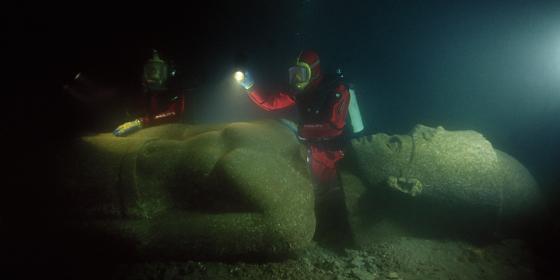
Photo: Christoph Gerigk/Franck Goddio/Hilti Foundation
In 2001, a joint French-English expedition was searching the bottom of Egypt’s Aboukir Bay for the wrecks of French warships sunk in the “Battle of the Nile” in 1798. Instead they re-discovered a lost city. Known as Thonis to the Egyptians and Heracleion to the Greeks, the port city was no more than before it was rediscovered 1,200 years after it sank into the sea. Now after more than a decade’s research, archaeologists have discovered a wealth of artifacts, revealing the trade and culture of a vibrant city at the center of Mediterranean trade. A new documentary Egypt’s Sunken City/ A Legend Is Revealed examines the discoveries and uses 3D modeling to recreate the ancient city. Thanks to Irwin Bryan and Alaric Bond for passing along the news.
Giant 16ft statues have been reassembled on the seabed 150ft below the surface before being brought ashore, as well as hundreds of smaller statues of Egyptian gods. Other finds include stone blocks with both Greek and Ancient Egyptian inscriptions and dozens of sarcophagi believed to have contained mummified animals offered as sacrifices to Amun-Gereb.
The research team, led by Dr Goddio have yet to establish what cause the city to go down, but the main theory is that the unstable sediments Heracleion was built on collapsed, and in combination with a rising sea-levels, may have caused the entire area to drop 12 feet straight into the water. ‘We are just at the beginning of our research,’ Dr Goddio told the Telegraph. ’We will probably have to continue working for the next 200 years.’
City of Heracleion sunk into the Mediterranean sea 1,200 years ago
